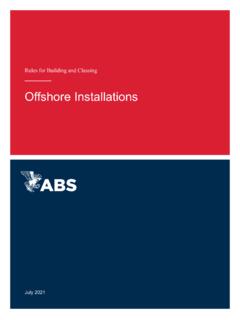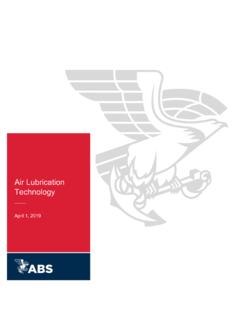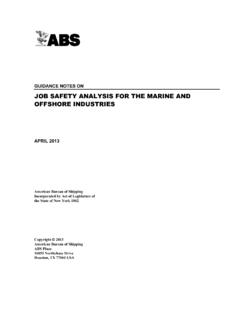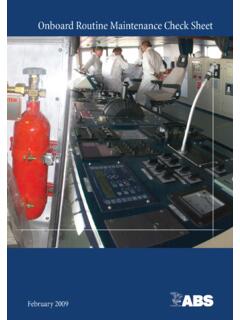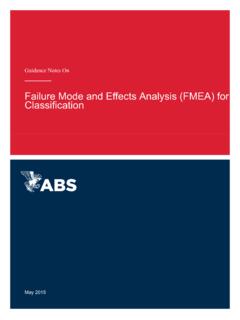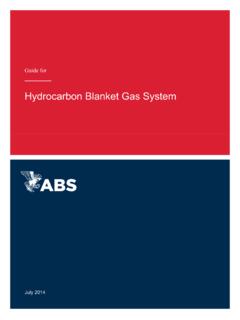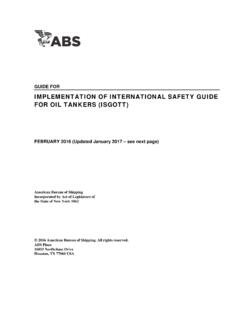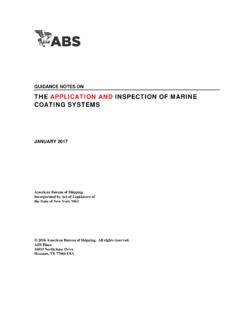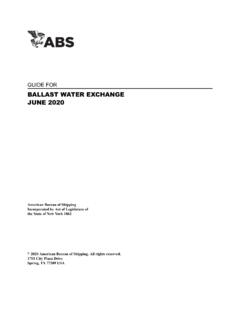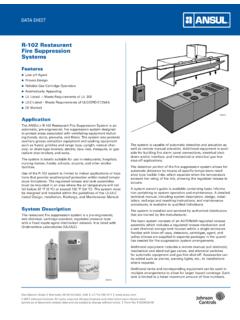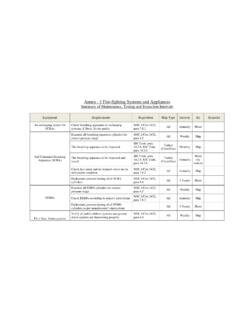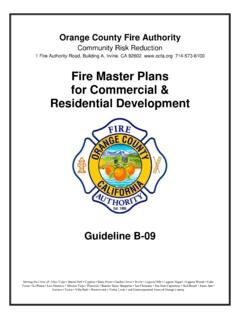Transcription of Guidance Notes on Fire-fighting Systems 2017
1 Guidance Notes on Fire-fighting Systems Guidance Notes ON Fire-fighting Systems JANUARY 2017 American Bureau of Shipping Incorporated by Act of Legislature of the State of New York 1862 2016 American Bureau of Shipping. All rights reserved. ABS Plaza 16855 Northchase Drive Houston, TX 77060 USA Foreword Foreword (2017) Purpose The ABS Rules incorporate many requirements intended to prevent the onset of a fire . However, even with all the preventative measures taken, shipboard fires still occur. Therefore, the proper design, installation and operation of the vessel s Fire-fighting Systems are critical to the safety of a vessel and the personnel onboard.
2 Since Fire-fighting Systems are so critical, the designs and arrangements of such Systems should be carefully evaluated for compliance with the ABS requirements by the designer and ABS Engineering staffs. These Guidance Notes have been developed to assist in a better understanding of the ABS requirements for such Systems . They are intended to provide a general overview of ABS requirements that should be considered during technical plan review activities. These Guidance Notes also examine the basic scientific fundamentals of fire , as appropriate for a proper understanding and application of the ABS requirements.
3 Accordingly, this document should be considered as general Guidance only and the technical reviews of Fire-fighting Systems should verify compliance with all ABS Rules applicable to the specific vessel involved. Note: Rule references in these Guidance Notes ( 4-7-2 , etc.) are typically to the requirements found in the ABS Rules for Building and Classing Steel Vessels, unless noted otherwise. Scope The scope of this document is limited to the review of ABS requirements considered during the technical plan review of active Fire-fighting Systems onboard ABS-classed vessels. Passive fire protection arrangements, such as structural fire protection, as well as fire detection Systems , are outside the scope of this document.
4 Fire-fighting Systems of offshore facilities and installations are also outside the scope of this document. The review of Fire-fighting Systems for the International Maritime Organization s (IMO s) International Convention for the Safety of Life at Sea (SOLAS) requirements is also not within the scope of this document. However, in many cases, the ABS Rules for Fire-fighting Systems either incorporate or directly reference IMO SOLAS Fire-fighting system requirements. Accordingly, within the discussions of the ABS requirements for various Fire-fighting Systems , related interpretations of the associated SOLAS requirements, as developed by the International Association of Classification Societies (IACS), are identified.
5 These IACS interpretations are called Unified Interpretations (UI). As an IACS member, ABS is obligated to apply these UIs as appropriate interpretations of the SOLAS requirements, unless directed otherwise by the Flag Administration. Interpretations provided in the UIs should be considered when conducting technical plan reviews. Note: Development of appropriate Unified Interpretations and revision of existing UIs is an ongoing effort within the IACS Working Parties. Therefore, attention is directed to the latest edition of the IACS UI being available on the website In addition to the IACS UIs, IMO MSC Circular 1120 Unified Interpretations of SOLAS Chapter II-2, the FSS Code, the FTP Code and related fire Test Procedures (and its subsequent correction ( ) and amendments per Circulars 1436, 1491 and 1510) also provides Guidance regarding SOLAS Fire-fighting system requirements.
6 Many of the MSC Circular 1120 interpretations are based upon the IACS UI interpretations, while others provide revised or additional interpretations of the SOLAS requirements. A number of the MSC Circular interpretations have been included in the SOLAS 2000 consolidated edition and subsequently in the SOLAS Consolidated Editions 2004, 2009 and 2014. Consequently, these requirements were also incorporated into the ABS Rules. However, since the MSC Circulars interpretations identify useful information and Guidance relative to certain Rule requirements, selected IMO MSC interpretations have also been identified.
7 Note: Regarding classification requirements, MSC Circulars interpretations which are not included within SOLAS have not necessarily been officially adopted by ABS and should only be applied as directed by the ABS Chief Engineer s Office. Further, MSC Circulars interpretations may not be mandatory for any particular Flag Administration, except for those incorporated within SOLAS. Member Governments are only invited to use the annexed interpretations as Guidance , and therefore, specific instructions from the ABS Regulatory Affairs Department should be obtained regarding the application of these interpretations on behalf of any particular Administration.
8 Ii ABS Guidance Notes ON Fire-fighting Systems . 2017 Table of Contents Guidance Notes ON Fire-fighting Systems CONTENTS SECTION 1 Basics of a fire .. 1 1 Chemistry of fire .. 1 Oxidation .. 1 State of Products in fire Oxidation Process .. 1 2 Fundamentals of a fire .. 2 3 The fire Triangle .. 2 Fuel .. 3 Oxygen .. 4 Heat .. 5 4 The fire Tetrahedron .. 5 5 Extinguishment Considering the fire Tetrahedron .. 5 Removing the Fuel .. 6 Removing the Oxygen .. 6 Eliminating the Heat .. 6 Breaking the Chain Reaction .. 7 6 Hazardous/Combustible Materials .. 7 7 Heat .. 7 Gases .. 8 Smoke.
9 8 FIGURE 1 The fire Triangle .. 2 FIGURE 2 The fire Tetrahedron .. 5 SECTION 2 Classification of Fires .. 9 1 Overview .. 9 2 Class A Fires .. 10 Wood and Wood-based Materials .. 10 Textiles and Fibers .. 11 Plastics and Rubber .. 12 Locations of Class A Materials Onboard .. 13 Extinguishment of Class A Fires .. 14 3 Class B Fires .. 14 Flammable Liquids .. 14 Flammable Gases .. 16 ABS Guidance Notes ON Fire-fighting Systems . 2017 iii 4 Class C Fires .. 18 Types of Equipment .. 18 Electrical Faults that Cause Fires .. 19 Hazards of Electrical Fires .. 19 Locations of Electrical Equipment Onboard.
10 19 Extinguishment of Class C Fires .. 20 5 Class D Fires .. 20 Hazards/Characteristics of Specific Metals .. 20 Locations of Class D Materials Onboard .. 21 Extinguishment of Class D Fires .. 21 6 Class K or F Fires .. 21 Hazards/Characteristics of Fires Caused by Cooking Grease, Fats and Oils .. 21 Location of Cooking Grease, Fats and Oils Onboard .. 22 Extinguishment of Class K or F Fires .. 22 TABLE 1 fire Classifications .. 9 TABLE 2 Burning Characteristics of Synthetic Fibers .. 12 SECTION 3 fire Main Systems .. 24 1 General Principles of the fire Main system .. 24 2 Extinguishing Capabilities of Water.
